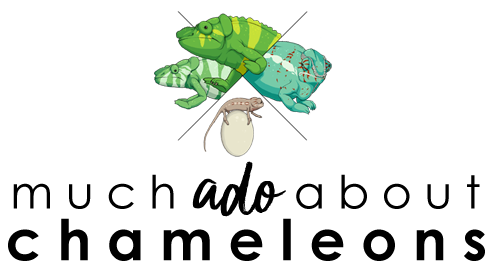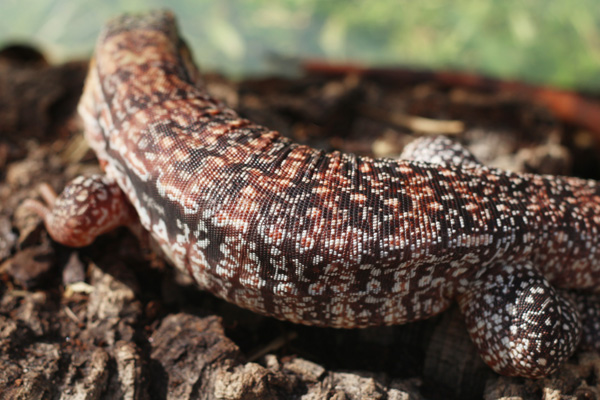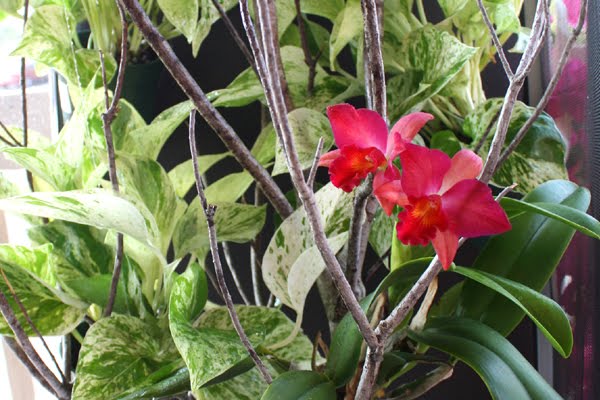A free-range (FR) is typically something you associate with poultry, but the term has found its way into a growing, alternative trend on how to keep chameleons. In this blog I talk a lot about the best screen cages to use and how best to set them up, but few people know that for over a year my chameleons had the run of their own room (and part of the living room) in what was a huge FR.
The idea consists of housing chameleons without cage walls, allowing them relative freedom to move about but still providing all their husbandry needs. This means that they still need their correct lighting, access to water, and food but without the cage walls. Many chameleons do incredibly well with this set-up, including but not limited to wild caught chameleons and large chameleon species (like Meller's, for example, who fit into both those descriptors.)
 |
| One side of my free-range room, with Cerberus the Ambilobe hanging out. |
THE GOOD
1. Chameleons tend to respond really well to not being caged. Even very aggressive, terrified chameleons usually relax and become more comfortable with people when they do not feel trapped/cornered in a cage. The great people at
The Chameleon Farm have a blog where they explain how to raise social chameleons, which includes free-ranging first and foremost. Their methods are amazing and I highly recommend checking it out.
 |
| Cobalt and Daedalus eating from the cricket bin together. |
2. Depending on the size of the FR, a large one allows them to exercise more, which lets them maintain a healthy weight and muscle tone. Obesity in chameleons is bad, and usually leads to problems with their liver eventually.
3. It lets them regulate their needs better. By not being trapped under a light all day long, they are able to choose whether to be under the heat light or the UVB bulb throughout the day.
4. You see a much more natural range of behavior and (dare I say it...) lots of personality. It seems that more space really brings out the full behavior spectrum of a chameleon, with all their quirks, weird little habits, and favorite activities. Males that would have fought otherwise forged "friendships."
THE BAD
1. You cannot set food items free in the cage for them to catch. You have to get used to either cup or hand feeding. So get used to (or get a set of tongs for) holding those bugs! And get used to the idea of a few of them escaping every so often from your grasp (or their mouth) and running around your home. Roommates may not be happy about this.
2. You have to hang the lights from the ceiling or something very tall. So making holes in the ceiling of a home you rent may not be a great option. But you don't want the chameleon climbing up the cord, onto the light, and burning himself. So I usually screw something into the ceiling from which I can hang my lights and then tape the cord along the wall, so no one can climb up.
 |
| See how the lights hang from the ceiling. And the metal frame for the misting system. |
4. Figuring out how to collect the mist/drip water is a bigger pain. You'll definitely have to get creative, or you'll end up ruining your floors. My solution was to turn my cage drainage tables into stands for my free range plants, and double as the drainage: How To Make A Drainage Table
A great idea to make a FR safer and keep them from wandering away into an unsafe area is to make a little smooth wall that they can't get over. One way to do this would be to take sheets of stiff acrylic, for example, cut them so they are taller than your chameleon is when standing, and make a fence around the FR perimeter. Glue or secure the pieces along the outside, so they can't climb up hinges or glue tracks. Something like the idea below:
THE UGLY
1. Free-ranging can be very dangerous. Pets (especially cats) are a huge risk, as are small children, electrical wires, sharp objects, etc. You have to carefully chameleon-proof the room they are in and then be very diligent about keeping other pets away. And then you have to be careful to check where you're walking, that you don't run them over with the door coming into the room, that you don't leave windows open, etc.
ADDITIONAL THOUGHTS
 |
| How many panthers can you spot in this photo? |
I free-ranged my entire gang for a year, and observed such amazing behavior from all of them. I saw them make friendships with unlikely partners (for example, two panther males became the best of friends). I saw how each one marked a territory within the room for himself, and they all respected each other. They would take turns eating from the feeding station or just share, depending on their mood. I saw them really communicating with each other via body language and settling disputes peacefully. It really was fascinating.
However, I did have to constantly check on them to make sure everything was ok, they were all still there, and find the one who maybe had wandered away looking for more food. It was more stressful than knowing they were each in their separate cages, safe and sound. And when I moved I decided to just make them each very large cages to live in.
But I do have plans to do it again when I am in a home where it is feasible again. With a little pre-planning and some ingenuity it's an amazing way to keep these animals.
But I do have plans to do it again when I am in a home where it is feasible again. With a little pre-planning and some ingenuity it's an amazing way to keep these animals.
Ambilobe and Nosy Be males became best friends. They'd drink off of each other.
|
































